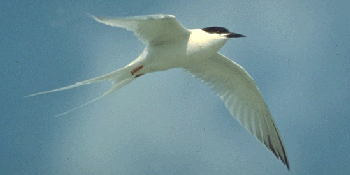 全球海鳥消失速度之快超過任何其他鳥類。此外,因棲地不易界定造成海鳥的保育工作比陸路鳥類困難。
全球海鳥消失速度之快超過任何其他鳥類。此外,因棲地不易界定造成海鳥的保育工作比陸路鳥類困難。
儘管如此,國際鳥盟(BirdLife International)和其合作夥伴為保護海鳥,特地制定了適用於全球重要海上野鳥棲地(Marine Important Bird Areas)的指導方針。
國際鳥盟的全球海上重要海鳥棲地的官員拉塞爾斯(Lascelles)表示:「我們已擬定了追踪海鳥的準則,並對所得數據加以分析,進而鎖定全球重要海上野鳥棲地。」
他還表示,全球海洋普遍缺乏保護。全球只有0.65%的海洋在保護區系統內,其中大多數也僅限於在離岸幾英里外的海上而已。
為妥善維護海洋生態,生物多樣性公約(Convention on Biological Diversity)和永續發展世界高峰會(World Summit on Sustainable Development)擬於2012年前,達成設立一個能代表全球海上保護區網絡的目標。
但是,按國際自然保育聯盟(IUCN)的估計,除非加快腳步否則要到2060年 -- 半個世紀之後,才有可能實現這個目標。
拉塞爾斯表示:「海鳥生存條件惡化的情況在IUCN紅色瀕危動物清單中,高於任何其他的鳥類族群。因此,除了持續施行緩解混獲的措施外,若要制止和扭轉海鳥數量迅速下降的趨勢,保護海鳥棲地絕對是迫在眉睫的任務。」
「因為許多海鳥大多數的時間生活在海上,所以保護海鳥的任務有其獨特的挑戰。」
為找尋海上重要海鳥棲地,國際鳥盟以陸地和淡水棲地的方法為借鏡,並經過不斷琢磨推敲以尋求適合海上環境的作法。為了實現該目標,國際鳥盟組織了一系列的工作坊,並邀約50位來自世界各地的海鳥追踪專家與會。與會代表比較了各種研究海鳥行蹤方法的優點,並測試了分析研究數據的最佳途徑。
國際鳥盟及其合作夥伴正努力爭取獲得即將於9月份在加拿大渥太華舉行的生物多樣性公約會議的研討會結果。
The world's seabirds are disappearing more quickly than any other group of bird species, and they are harder to conserve than birds based on land, where habitat can more easily be set aside for their protection.
To conserve seabirds despite these issues, BirdLife International and some of its partner organizations have developed guidelines for identifying Marine Important Bird Areas for seabirds that can be applied anywhere around the world.
"We now have agreed guidelines which can be used to track seabirds and analyze the data to identify Marine IBAs for any seabird species," said Ben Lascelles, BirdLife's Global Marine IBA officer.
The world's oceans are under-protected, he said. Just 0.65 percent of the global ocean is within protected area systems, and most of that is within the first few miles offshore.
To safeguard the oceans, the Convention on Biological Diversity and the World Summit on Sustainable Development set a target to establish a globally representative network of Marine Protected Areas by 2012.
But the International Union for the Conservation of Nature, IUCN, estimates that unless progress is accelerated, this goal will not be met until 2060 - half a century late.
"Seabirds have deteriorated in IUCN Red List status faster than any other group of bird species" said Lascelles. "As well as continuing the implementation of bycatch mitigation measures, we urgently need to protect their habitats if we are to stop and reverse these rapid declines."
Seabird conservation presents some unique challenges, as many species spend the majority of their lives at sea.
To identify Marine IBAs, BirdLife has been refining methods developed for land and freshwater sites to ensure they work in the marine environment.
In order to achieve this, BirdLife organized a series of workshops which were attended by 50 seabird tracking experts from around the world. Workshop delegates compared the merits of different methods used to study the movements of seabirds, and tested the best ways of analyzing the datasets gained from such studies.
BirdLife and its partners are now working towards getting the outcomes of the workshops endorsed by the Convention on Biological Diversity at its upcoming September meeting in Ottawa, Canada.





